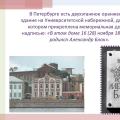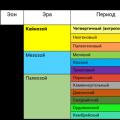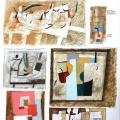How to read the letter q in English. English alphabet
Anyone who begins to learn English must, at the first stage of their journey, encounter the alphabet and the pronunciation of its letters. It is very important not only to know what the letters are called, but also to know Russian pronunciation in general.
For correct pronunciation alphabet Below is a table of all letters with both English and Russian transcriptions. Of course, you need to know English transcription - it is used in any dictionary, it is as important as knowledge of the alphabet itself. But for beginners who have not yet fully mastered English transcription, we give the sounds of the English alphabet in Russian letters.
| Letter | Name | Pronunciation | Russian recording letter names |
| a | a | Hey | |
| b | bee | bi | |
| c | cee | si | |
| d | dee | di | |
| e | e | And | |
| f | ef | ef | |
| g | gee | ji | |
| h | aitch | HH | |
| i | i | ah | |
| j | Jay | Jay | |
| k | kay | kay | |
| l | el | el | |
| m | em | Em | |
| n | enn | en | |
| o | o | oh | |
| p | pee | pi | |
| q | cue | Cue | |
| r | ar | a, ar | |
| s | ess | es | |
| t | tee | you | |
| u | u | yu | |
| v | vee | vi | |
| w | double-u | [`dʌbl `ju:] | double |
| x | ex | ex | |
| y | wy | wy | |
| z | zed, zee | , | zed, zi |
As for the letter Z, the British version is “zed”, the American version is “zi”.
It may seem that the English alphabet is more complex than the Russian one. But in reality this is not the case. It has only 26 letters (for comparison in Russian - 33), and only 6 of them (A, E, I, O, U, Y) are vowels. Unfortunately, these vowel letters do not always correspond to alphabetic pronunciation. For example, Aa - in the alphabet is read as [hey]: “cake” - cake, “later” - later, but not in the words “bag” - luggage, “flag” - flag and many others.
Here it must be said that in English distinguish between stressed and unstressed syllables. Let's look at the case of a stressed syllable. Here you can also observe division - the stressed syllable can be open and closed. Open syllables end with a vowel, and closed syllables end with a consonant. Here are examples of drums open syllables: “la-bel” – inscription, “ta-ke” – to receive, and so on. Here are examples of stressed closed syllables: “rab-bit” - rabbit, “dog” - dog, “win-dow” - window, and so on. Please note that in the first case, the stressed vowels are read exactly the same as they sound in the alphabet.
Let's look at all the vowels:
Vowel A
Open syllable: “la-ter” [’leitə] – later
Closed syllable: “cat” - cat
Vowel E
Open syllable: “he” - he
Closed syllable: “bend” - bend
Vowel I
Open syllable: “li-lac” [’lailək] - lilac
Closed syllable: “lift” - lift
Vowel O [?u]
Open syllable: “pho-to” [’fəutəu] - photograph
Closed syllable: “got” - received
Vowel U
Open syllable: “cu-te” - cute
Closed syllable: “numb” - numb
Vowel Y
Open syllable: “type” - type on a typewriter
Closed syllable: “myth” - myth
 Fine. Now, continuing to answer the question of how the English alphabet is read, we need to talk about unstressed vowels. The vowels a, o, u, when not under stress, turn into the sound [ə], and the vowels e, i, y in the same case become the sound [i]. In this case, as soon as the letters r appear after them, they all become [ə]. You can easily see this for yourself: “pre-fer” - to prefer, “pla-yer” [’pleiə:] - player, “doctor” [’dɔktə:] - doctor.
Fine. Now, continuing to answer the question of how the English alphabet is read, we need to talk about unstressed vowels. The vowels a, o, u, when not under stress, turn into the sound [ə], and the vowels e, i, y in the same case become the sound [i]. In this case, as soon as the letters r appear after them, they all become [ə]. You can easily see this for yourself: “pre-fer” - to prefer, “pla-yer” [’pleiə:] - player, “doctor” [’dɔktə:] - doctor.
It is also worth paying attention to the consonant letters: B, D, F, H, J, K, L, M, N, P, T, V, W, X, Z - also read accordingly [b], [d], [ f], [h], , [k], [l], [m], [n], [p], [t], [v], [w], [x], [z]. Things are more complicated with the remaining consonants.
So, for example, the letter C will be before e, i, y, and in all other cases – [k]. See: “cinema” [’sinəmə] – cinema, “cure” – treatment.
The letter G - before e, i, y goes into , and in other cases as [g]: “ginger” [’dʒindʒə] - ginger, “goat” - goat, goat.
And S at the beginning of a word and after voiceless words consonants K, F, P and T is read as the sound [s], and, on the contrary, after voiced and other cases - [z]: “Simon” ['saimən] - Simon, “books” - books, “finds” - finds, “wise” - wise .
The letters R and Q are also tricky. So R is often simply dropped, lengthening the sound (“car” - car), but a word with R will be read with R (“Riko” - Rico). The letter Q can give two options - or - compare “quick” - quickly and “queue” - queue.
Learn more about what the stroke, colon, parentheses and other symbols.
You can see another option English transcription and if it needs to be printed or copied for editing in Microsoft Word
English Transcription
Pronunciation of English sounds.
Pronunciation of English vowels.
The pronunciation of English sounds is presented in Russian letters, you should understand what to convey the correct English pronunciation Using the Russian alphabet is not possible.
- ɑː long, deep
- ʌ short vowel a, as in the Russian word run.
- ɒ = ɔ - short, open about
- ɔː - long o
- zː - long vowel e, as in the Russian word hedgehog.
- æ - open e
- e - like e in the word these
- ə - unclear unstressed sound, similar to e
- iː - long and
- ɪ - short, open and
- ʊ = u - short u, pronounced with a slight rounding of the lips.
- uː - long u pronounced without strong rounding of the lips.
Two-vowel sounds
Pronunciation of English consonants.
- p - p
- b - b
- m - m
- f - f
- v - in
- s - s
- z - z
- t - resembles the Russian sound t, pronounced with the tongue positioned at the gums.
- d - resembles the Russian sound d, pronounced with the tongue positioned at the gums.
- n - resembles the Russian sound n, pronounced with the tongue positioned at the gums.
- l - resembles the Russian sound l, pronounced with the tongue positioned at the gums.
- r is a very hard sound pronounced without vibration of the tongue. Corresponds to the sound r in the word lot
- ʃ - soft Russian sh
- ʒ - soft Russian zh, as in the word yeast.
- tʃ- h
- ʤ - similar to the Russian sound j (voiced ch)
- k - k
- h - inhale, reminiscent of a faintly pronounced x sound
- ju - long yu in the word southern
- je - sound e in the word spruce
- jɔ - sound ё in the word fir-tree
- jʌ - the sound I in the word pit
- j - resembles the Russian sound й before vowels. Occurs in combination with vowels.
English consonant sounds that have no approximate correspondence in Russianː
- w - formed with the help of rounded lips (as in whistling). It looks like a sound uttered with just lips. In translation it is denoted by the letters в or у ː W illiams - Williams, Williams.
- ƞ - Open your mouth slightly and say n without closing your mouth.
- ɵ - Move the slightly spread tip of your tongue between your teeth and pronounce Russian with
- ð - Move the slightly spread tip of your tongue between your teeth and pronounce Russian z
This tutorial will help you add a gorgeous glassy and transparent effect to your text yourself.
This effect involves using a variety of layer styles. To make things easier for you, at the end of the lesson there is a PSD file that you can download and copy all the layer styles to your document.
Create a beautiful background.
For our effect we will create a gradient consisting of three colors. It will smoothly flow from green to dark blue.
So, set the settings to Radial Gradient.
Click on the gradient bar to set the following colors.
Color 1 - #2e5b15
Color 2 - #103533
Color 3 - #090e13

Now write your favorite letter. Here the color used for the letter is #41a993.

There you need to go to the layer with the letter, right-click - select Copy layer style (Copy layer style), then go to your letter and select the command Paste Layer Styles (Paste layer styles)
When you transfer the layer styles, you can look at their settings, you may want to edit something.
After that, reduce the Fill parameter to 20%.
This option will make the fill color transparent, but will not affect the applied layer styles.

As a result, you should end up with something like this:
Note that the styles were chosen in such a way as to show that the light falls on the letter from below (where the green color of the gradient shines)

Now hold Ctrl and click on the letter layer to load the selection. Create a new layer, set a gradient from white to transparent, and draw the gradient from the bottom diagonally (from the intended source).

And then change the blend mode to Overlay/Overlap.
And again, load a selection around the letter (Ctrl + click on the layer). Create a new layer, add the same gradient from white to transparent as shown in the image (top to bottom)
Reduce the transparency/opacity to 40%.

Now standing on the same layer, draw an oval selection and click Ctrl+Shift+I to invert the selection. Click Delete to remove part of the gradient we added in the last step.
This will abruptly break the white gradient and give the letter a glassy effect.

Your letter should now shine as if it had just been washed.
But you can add even more sparkle with tiny stars.
Such stars can be made as follows:
Find the Shapes tool, there you will also see the polygon tool. Click on it, and then follow the down arrow to set its parameters.
Check the box next to Star and also set the value to 99%

Now on a new layer, with white color, add some shining stars. It is best to place them in the lightest areas.
Finish! Here is a magnificent glass creation!
 Presentation on the topic "A.A. Blok". Presentation on the topic "Alexander Alexandrovich Blok" Family and relatives
Presentation on the topic "A.A. Blok". Presentation on the topic "Alexander Alexandrovich Blok" Family and relatives Geological chronology The paleontological method is based on the study of fossil organisms and plants buried in rock strata
Geological chronology The paleontological method is based on the study of fossil organisms and plants buried in rock strata Myths about creativity that turned out to be untrue, but still poison our lives
Myths about creativity that turned out to be untrue, but still poison our lives